|
|
|
Sort Order |
|
|
|
Items / Page
|
|
|
|
|
|
|
| Srl | Item |
| 1 |
ID:
181340
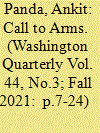

|
|
|
|
|
| Summary/Abstract |
Having declared his nuclear deterrent “complete” following the testing of three intercontinental-range ballistic missiles (ICBMs) and a thermonuclear device in 2017, North Korean leader Kim Jong Un has been overseeing a period of qualitative nuclear modernization and quantitative force expansion. North Korea’s nuclear forces continued to grow during the short-lived period of diplomacy with South Korea and the United States in 2018 and 2019. In January 2021, in reviewing the accomplishments of the five-year period following North Korea’s Seventh Party Congress in 2016, Kim alluded to “tactical nuclear weapons” among other significant accomplishments concerning his nuclear forces during that era. This was a notable statement. Traditionally, North Korea has referred to its nuclear capabilities euphemistically as “strategic” weapons. When references to tactical nuclear weapons (TNW) would appear in state media, they would reference US nuclear capabilities; North Korea has never acknowledged that the United States withdrew its last nuclear weapons from the Korean Peninsula in December 1991.
|
|
|
|
|
|
|
|
|
|
|
|
|
|
|
|
| 2 |
ID:
164309
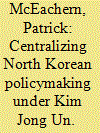

|
|
|
|
|
| Summary/Abstract |
Following the death of North Korean leader Kim Jong Il in December 2011, Kim Jong Un assumed power and gradually transformed the policymaking environment in the Democratic People's Republic of Korea (DPRK or North Korea). While some analysts expected the young and inexperienced leader to face greater hardship than his father in managing the country, in this article I argue that Kim Jong Un faced an easier transition. Kim Jong Un inherited an economy, inter-Korean relationship, and strategic landscape in foreign affairs in a relatively favorable position relative to his father's formal succession. From this position of strength, Kim Jong Un has centralized governance in the Korean Workers' Party (KWP) and his personal leadership. Drawing on internal documents and media, I show that inter-institutional debate previously observable between the party, military, and government has largely vanished under Kim Jong Un and the political roles of the military and government have receded from a comprehensive set of national policy questions.
|
|
|
|
|
|
|
|
|
|
|
|
|
|
|
|
| 3 |
ID:
180870
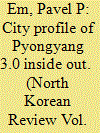

|
|
|
| 4 |
ID:
167946


|
|
|
|
|
| Summary/Abstract |
This paper analyzes the background of the nuclear stalemate between Trump and
Kim in the Hanoi Summit and investigates various issues involving North Korean
denuclearization, including a detailed roadmap and proper compensation for
Pyongyang. The paper uses tree cardinal perspectives of analytical tools (the will of
the leader, nuclear capability, and nuclear strategy) to critically assess North Korea’s
nuclear weapons program and fathom Kim Jong Un’s stance on denuclearization.
The United States reaffirms CVID/FFVD principles regarding North Korea’s
WMD, while Pyongyang prefers an action-for-action method of denuclearization.
Although Pyongyang has announced an end to its nuclear testing and has shut down
nuclear facilities, experts question whether Pyongyang really is dismantling its
nuclear program. Pyongyang’s hidden nuclear facilities and accumulation of HEU
in numerous places, the complicated process of verification, as well as potential
traps in the details of the denuclearization agreement pose a big challenge. In light
of the current nuclear stalemate, President Moon’s mediating effort to bring Kim
Jong Un back to the denuclearization table is imperative.
|
|
|
|
|
|
|
|
|
|
|
|
|
|
|
|
| 5 |
ID:
185895
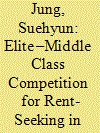

|
|
|
|
|
| Summary/Abstract |
This paper examines the anti-corruption movement initiated by Kim Jong Un, focusing on the increased rent-seeking competition between the elite and the middle class as market mechanisms have developed in North Korea. I examine two hypotheses regarding this program. First, it is focused on constraining the influence gained by the elite through power–money collusion to maintain regime stability. Second, it aims to support decentralizing economic reforms and the direction of production surplus into state finances, to secure state revenue. In substantiating these hypotheses, I argue that the movement is driven by the goal of capitalizing on the benefits of the market without compromising regime security, by regulating “competitive rent-seeking” between the elite and the middle class.
|
|
|
|
|
|
|
|
|
|
|
|
|
|
|
|
| 6 |
ID:
116680
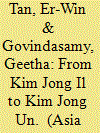

|
|
|
|
|
| Publication |
2012.
|
| Summary/Abstract |
The recent death of Kim Jong Il and the succession of his son, Kim Jong Un, as Supreme Leader of the Democratic People's Republic of Korea leaves the Northeast Asian region at a crossroads. Given the younger Kim's lack of political experience, it is reasonable to believe that his priority will be on consolidation of his political and military power base in Pyongyang. More recently, the Democratic People's Republic of Korea (DPRK) has sent mixed signals with regard to its intentions. On the one hand, North Korea has agreed to a moratorium of its nuclear activities and has even invited the IAEA to inspect its nuclear facilities; at the same time, however, the DPRK has also announced its plan to launch a satellite in mid-April, using technology derived from the Taepodong missile. Set against this backdrop, we underline and comparatively assess the importance of the USA, the Republic of Korea, and China, all of which will be going through a political transition in 2012. We conclude that Seoul and Beijing are in the best position to reopen the process of dialogue with the DPRK.
|
|
|
|
|
|
|
|
|
|
|
|
|
|
|
|
| 7 |
ID:
151253
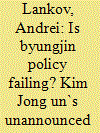

|
|
|
|
|
| Summary/Abstract |
The potential success of North Korea`s policy commonly known as “Byungjin (simultaneous advancement) Line,” is the topic of the present article. Since 2012, the new North Korean leadership has implemented a policy of Byungjin, which implies three major components: cautious market-oriented economic reforms, the development of a full-scale nuclear strike force, and maintenance of very strict surveillance and control systems domestically. It has been argued that the Byungjin policy cannot possibly succeed, but this article demonstrates that, so far, the policy has produced some notable results and delivered a measure of economic growth. This article further argues that the Byungjin policy has the potential of achieving a measure of long-term success, allowing Kim Jong Un and his system to survive for some time, maintaining both political stability and economic growth. It also argues that, given the peculiar international situation of North Korea, and other important variables, including Kim Jong Un`s age, the policy makes perfect sense―if judged from the perspective of the North Korean hereditary ruling elite. This article considers the problems Kim Jong Un`s model of authoritarian developmentalism will face and focuses on both de-stabilizing and stabilizing factors currently at work in North Korea. The article concludes that success of the Byungjin policy is possible, but will lead to a number of new challenges for the outside world.
|
|
|
|
|
|
|
|
|
|
|
|
|
|
|
|
| 8 |
ID:
114104
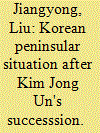

|
|
|
| 9 |
ID:
120995
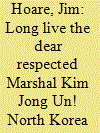

|
|
|
|
|
| Publication |
2013.
|
| Summary/Abstract |
There had long been speculation as to who would succeed Kim Jong Il, the ruler of North Korea. When he died in December 2011, it was his youngest son, Kim Jong Un who took over. Little enough is known about how N. Korea is run, but the difficulties of getting the country's leaders to modify their ways remain as great as ever. There were no obvious signs of change on the domestic front, though the military seemed somewhat less prominent. And continuity was also evident in relations with South Korea, now at a very low ebb. The issue of missile and nuclear development is equally bleak. The Leap Day Agreement with the US quickly became a dead letter, and as 2012 went on, North Korean belligerence was fuelled by UN resolutions. Much of this was routine theatre, but North Korea's third nuclear test on 12 February 2013 provoked sharper international criticism and a correspondingly shriller response from the North. In spite of calls for China to intervene, the real target for this hostility is the US. But with each side unwilling to engage except in terms that the other side finds unacceptable, it is hard to see how progress can be achieved.
|
|
|
|
|
|
|
|
|
|
|
|
|
|
|
|
| 10 |
ID:
120347
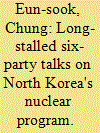

|
|
|
| 11 |
ID:
187226
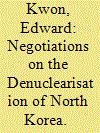

|
|
|
|
|
| Summary/Abstract |
This article analyzes a series of summit diplomacy efforts by the former United States President Donald Trump, and South Korea's President Moon Jae-in, to persuade North Korean leader Kim Jong Un to give up the country's nuclear weapons program. Through critical evaluation of the summits between Trump and Kim as well as Moon and Kim, the paper provides several important lessons on how to deal with North Korea. Kim Jong Un's mindset and strategic calculation of a denuclearization deal with Trump, amid the recent progress of North Korea's nuclear weapons and ICBMs programs, are investigated. Given the failure to reach a denuclearization agreement at the Hanoi Summit, Pyongyang is not expected readily to give up its nuclear weapons. North Korea had temporarily refrained from severe military provocations, such as test-firing ICBMs or conducting another round of nuclear weapon experiments by self-moratorium since April 2018. However, Pyongyang reversed direction with this policy in 2022 and resumed coercive diplomacy in order to achieve its desired goals. As North Korea's incessant efforts to advance its nuclear weapons and ICBMs programs brings with a dismal outlook for peace building both on the Korean Peninsula and the world, this paper investigates a series of policy lessons to manage the North Korean nuclear crisis.
|
|
|
|
|
|
|
|
|
|
|
|
|
|
|
|
| 12 |
ID:
119104
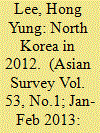

|
|
|
|
|
| Publication |
2013.
|
| Summary/Abstract |
Thus far, North Korea appears to have made a successful transition of power to the third generation of Kims, installing the 28-year-old Kim Jong Un as the country's supreme leader. However, due to the diminishing legitimacy of multiple generations of inherited leadership, Kim Jong Un must deliver what North Korea needs most, namely, economic development. Kim has promised to give it priority, but structural (political, economic, and social) constraints do not allow him much room to maneuver.
|
|
|
|
|
|
|
|
|
|
|
|
|
|
|
|
| 13 |
ID:
130191
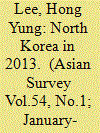

|
|
|
|
|
| Publication |
2014.
|
| Summary/Abstract |
The second year of Kim Jong Un's rule in North Korea was enormously eventful. The year began with Pyongyang carrying out its third nuclear test, a move of reckless brinksmanship that alarmed the region and beyond. North Korea formally declared its goal of ''simultaneously pursuing nuclear and economic development,'' but failed to take a decisive step toward economic reform. The ruthless purge and execution of Jang Song-taek revealed the structural weakness of the ruling system.
|
|
|
|
|
|
|
|
|
|
|
|
|
|
|
|
| 14 |
ID:
137907
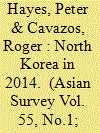

|
|
|
|
|
| Summary/Abstract |
In 2014, North Korea neither overcame its isolation due to its nuclear weapons and hostile geostrategic posture nor reformed its economy. Kim Jong Un learned on the job, consolidated his leadership, avoided military risk, and opened new channels to South Korea, Japan, and Russia to reduce dependence on China.
|
|
|
|
|
|
|
|
|
|
|
|
|
|
|
|
| 15 |
ID:
145435
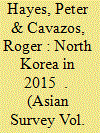

|
|
|
|
|
| Summary/Abstract |
North Korea upgraded its nuclear and military power and grew its economy slightly, thereby realizing Kim Jong Un’s byungjin line. It also attempted to open new external fronts and to coerce the South to cooperate on its terms, but failed. Instead, it retreated into a repaired relationship with China.
|
|
|
|
|
|
|
|
|
|
|
|
|
|
|
|
| 16 |
ID:
152250
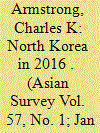

|
|
|
|
|
| Summary/Abstract |
Kim Jong Un further consolidated his leadership position at the Seventh Congress of the Workers’ Party in May, the first congress since 1980. Pyongyang conducted two nuclear tests and made advances in missile delivery, eliciting strong sanctions resolutions from the UN Security Council, first in March and again in November.
|
|
|
|
|
|
|
|
|
|
|
|
|
|
|
|
| 17 |
ID:
172462


|
|
|
|
|
| Summary/Abstract |
This was a year of transition in North Korea, as leader Kim Jong Un held firm to his strategic shift of putting “all efforts” into economic development in the face of ongoing international sanctions. Kim’s summit diplomacy with the US and South Korea stalled, while ties improved markedly with China and modestly with Russia. The US and South Korea resumed downsized joint military exercises and North Korea resumed short-range missile testing.
|
|
|
|
|
|
|
|
|
|
|
|
|
|
|
|
| 18 |
ID:
179244
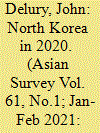

|
|
|
|
|
| Summary/Abstract |
North Korea slogged through 2020 in an effort to maintain public health and state power. Kim Jong Un’s hopes for an economic breakthrough were dashed by the COVID-19 outbreak in neighboring China, which posed an existential threat given the DPRK’s limited healthcare resources. Although swift sealing of borders helped prevent a crisis, keeping the country on national quarantine took a heavy toll. Information about internal developments was scarce this year, as demonstrated by the global media’s frenzied speculation in the spring that Kim Jong Un had died. Kim did scale down his public appearances, but convened frequent sessions of the ruling Politburo, often to complain about Party failings, and his sister Kim Yo Jong elevated her profile with tough messages for Seoul and Washington. North Korea remained inwardly focused to the end of the year, rebuffing South Korean entreaties at cooperation and ignoring the presidential election in the United States.
|
|
|
|
|
|
|
|
|
|
|
|
|
|
|
|
| 19 |
ID:
185200
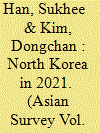

|
|
|
|
|
| Summary/Abstract |
Continuing the trendline of 2020, North Korea’s key priorities in 2021 were to tighten its belt economically and control the COVID-19 pandemic. Those two goals were related. With its healthcare system no match for such a public health crisis, the government continued its utmost effort to prevent a COVID-19 disaster through the near-complete closure of its borders, severely hampering vital trade with China. As seen in the 8th Congress of the Workers’ Party of North Korea, however, chairman Kim Jong-un also prioritized maintaining an assertive stance toward the United States, even to the point of abjuring negotiations with Washington that might have unlocked vaccines or medical assistance. Instead, North Korea frequently criticized the US’s “hostile position” and carried out a variety of missile tests, which seemed more provocative and capable throughout the year. Pyongyang also restarted the Yongbyon nuclear facilities for producing fissile materials. This assertive and provocative behavior was emboldened by steadily closer ties with traditional allies, notably China and Russia. Meanwhile, North Korea largely showed a cold, dismissive attitude to its southern counterpart.
|
|
|
|
|
|
|
|
|
|
|
|
|
|
|
|
| 20 |
ID:
146721


|
|
|
|
|
|
|
|